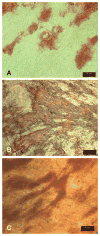Bioactive glass coatings affect the behavior of osteoblast-like cells
- PMID: 17466608
- PMCID: PMC2093947
- DOI: 10.1016/j.actbio.2007.02.011
Bioactive glass coatings affect the behavior of osteoblast-like cells
Abstract
Functionally graded coatings (FGCs) of bioactive glass on titanium alloy (Ti6Al4V) were fabricated by the enameling technique. These innovative coatings may be an alternative to plasma-sprayed, hydroxyapatite-coated implants. Previously we determined that a preconditioning treatment in simulated body fluid (SBF) helped to stabilize FGCs [Foppiano S et al. Acta Biomater 2006;2(2):133-42]. The primary goal of this work was to assess the in vitro cytocompatibility of preconditioned FGCs with MC3T3-E1.4 mouse pre-osteoblastic cells. We evaluated cell adhesion, proliferation and mineralization on FGCs in comparison to uncoated Ti6Al4V and tissue culture polystyrene (TCPS). No difference in cell adhesion was identified, whereas proliferation was significantly different on all materials, being highest on FGCs followed by TCPS and Ti6Al4V. Qualitative and quantitative mineralization assays indicated that mineralization occurred on all materials. The amount of inorganic phosphate released by the mineralizing layers was significantly different, being highest on TCPS, followed by FGC and uncoated Ti6Al4V. The secondary objective of this work was to assess the ability of the FGCs to affect gene expression, indirectly, by means of their dissolution products, which was assessed by real-time reverse-transcription polymerase chain reaction. The FGC dissolution products induced a 2-fold increase in the expression of Runx-2, and a 20% decrease in the expression of collagen type 1 with respect to TCPS extract. These genes are regulators of osteoblast differentiation and mineralization, respectively. The findings of this study indicate that preconditioned FGCs are cytocompatible and suggest that future work may allow composition changes to induce preferred gene expression.
Figures





References
-
- Gomez-Vega JM, Saiz E, Tomsia AP. Glass-based coatings for titanium implant alloys. J Biomed Mater Res. 1999;46(4):549–59. - PubMed
-
- Gomez-Vega JM, et al. Bioactive glass coatings with hydroxyapatite and Bioglass particles on Ti-based implants. 1. Processing Biomaterials. 2000;21(2):105–11. - PubMed
-
- Hench L, Anderson O. Bioactive glasses. In: Hench LL, Wilson J, editors. An Introduction to Bioceramics. World Scientific; Singapore: 1993. pp. 41–62.
-
- Foppiano S, et al. Functionally graded bioactive coatings: reproducibility and stability of the coating under cell culture conditions. Acta Biomater. 2006;2(2):133–42. - PubMed
-
- Radin S, et al. The effect of in vitro modeling conditions on the surface reactions of bioactive glass. J Biomed Mater Res. 1997;37(3):363–75. - PubMed
Publication types
MeSH terms
Substances
Grants and funding
LinkOut - more resources
Full Text Sources
Other Literature Sources

